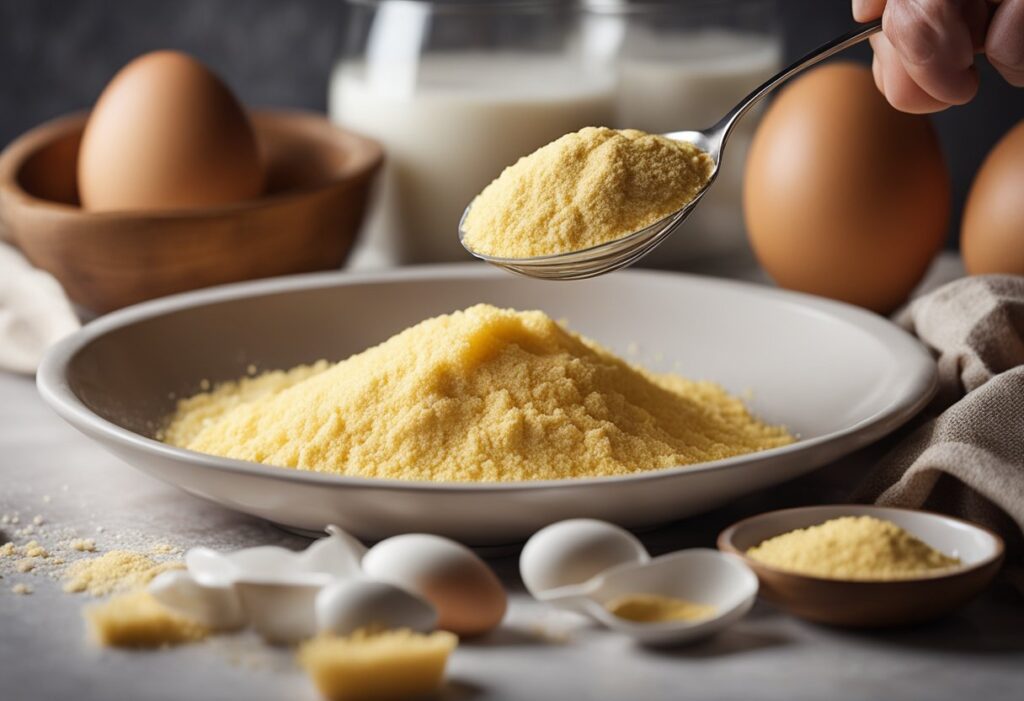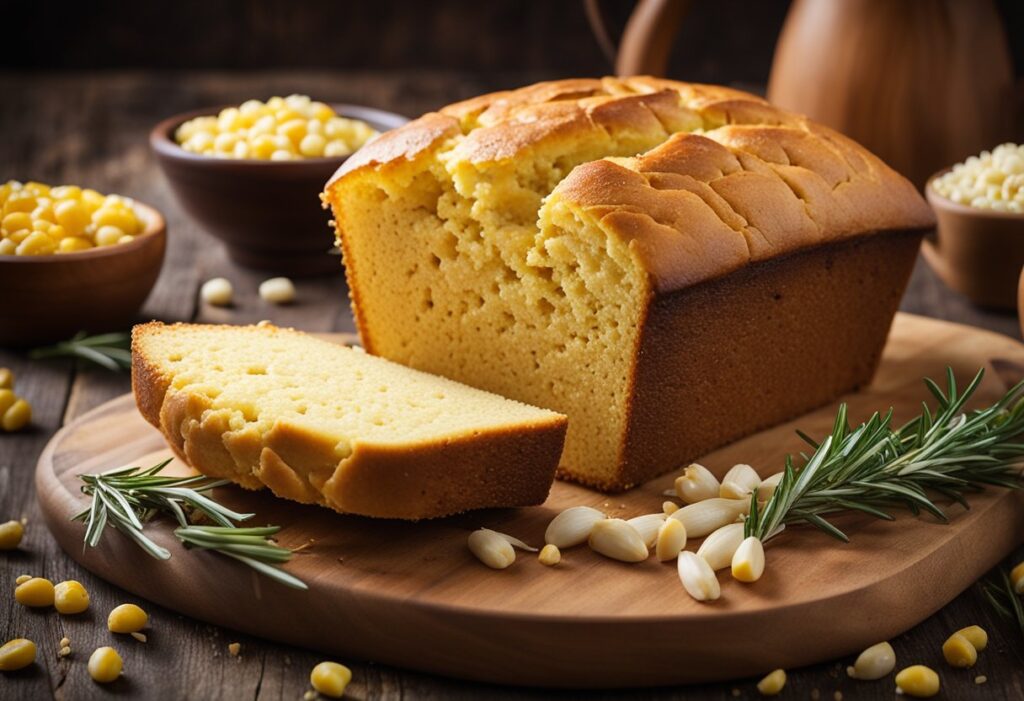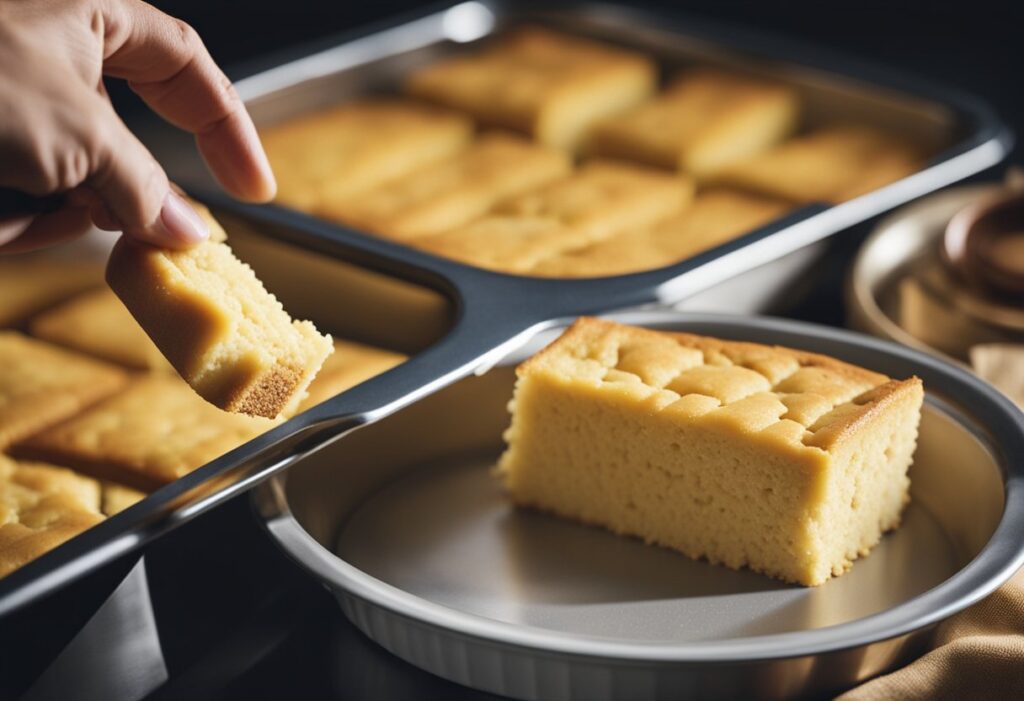Cornbread is a classic American dish that has been enjoyed for generations. However, for those with gluten sensitivities or celiac disease, traditional cornbread recipes can be off-limits. Fortunately, there are many gluten-free alternatives available, including a delicious gluten free cornbread recipe that is easy to make and just as tasty as the original.
Table of Contents

This gluten free cornbread recipe uses a combination of gluten-free cornmeal, gluten-free flour, and other simple ingredients to create a moist and flavorful bread that is perfect for any occasion. Whether you are looking for a side dish for your next barbecue or a tasty snack to enjoy with your morning coffee, this recipe is sure to please.
By using gluten-free ingredients, this cornbread recipe is not only safe for those with gluten sensitivities, but it is also a healthier option for everyone. Gluten-free flours and cornmeal are often higher in fiber and lower in carbohydrates than their traditional counterparts, making this recipe a great choice for anyone looking to eat a healthier diet.
Understanding Gluten-Free Diets
Gluten-free diets have become increasingly popular in recent years. Gluten is a protein found in wheat, barley, and rye, and it is what gives bread its elasticity and chewiness. However, for some people, consuming gluten can cause adverse reactions in their bodies. This is because they have celiac disease, a condition in which the immune system attacks the small intestine when gluten is consumed.
For others, consuming gluten can cause non-celiac gluten sensitivity, which is a less severe condition than celiac disease. People with this condition experience symptoms such as abdominal pain, bloating, and diarrhea when they consume gluten.
Gluten-free diets involve avoiding foods that contain gluten, including bread, pasta, and baked goods. However, it is important to note that many foods that do not contain gluten naturally can still be contaminated with gluten during processing. Therefore, it is important for people following a gluten-free diet to read food labels carefully and avoid cross-contamination in their kitchens.
Fortunately, there are many gluten-free alternatives available for people who need to avoid gluten. These include grains such as rice, quinoa, and corn, as well as gluten-free flours made from almond, coconut, or chickpeas. It is also important for people following a gluten-free diet to ensure they are getting enough nutrients, as some gluten-free products may not be fortified with vitamins and minerals.
Overall, understanding gluten-free diets is important for people with celiac disease or non-celiac gluten sensitivity. By avoiding gluten and ensuring they are getting enough nutrients, people with these conditions can manage their symptoms and live a healthy life.
Choosing the Right Ingredients
When it comes to making gluten-free cornbread, choosing the right ingredients is crucial to achieving a delicious and moist texture. Here are some tips to help you select the best ingredients for your recipe:
Cornmeal
Cornmeal is the main ingredient in cornbread, and it’s important to choose the right type for a gluten-free recipe. Look for cornmeal that is labeled as “gluten-free” to ensure that it has not been contaminated with wheat or other gluten-containing grains.
Flour
To give your cornbread the right texture and structure, you’ll need to add a gluten-free flour to the recipe. Some good options include rice flour, almond flour, and coconut flour. Be sure to choose a flour that is labeled as gluten-free to avoid any cross-contamination.
Sweetener
Many cornbread recipes call for sugar or honey to add sweetness. For a gluten-free recipe, you can use any type of sweetener that you prefer, such as maple syrup or agave nectar. Just be sure to check that your chosen sweetener is gluten-free.
Dairy
Some cornbread recipes call for milk or butter, but if you’re lactose intolerant or following a dairy-free diet, you can use non-dairy alternatives such as almond milk or coconut oil. Just make sure to choose a product that is labeled as gluten-free.
By following these tips and choosing the right ingredients, you can create a delicious gluten-free cornbread that everyone will love.
Gluten-Free Cornmeal Selection

When it comes to making gluten-free cornbread, selecting the right cornmeal is crucial. It is important to choose a cornmeal that is labeled gluten-free to ensure that it has not been cross-contaminated with gluten during processing.
There are several types of cornmeal available, including fine, medium, and coarse grind. Fine grind cornmeal is best for making cakes and muffins, while medium and coarse grind cornmeal are better suited for making cornbread.
It is also important to consider the type of corn used to make the cornmeal. White cornmeal has a milder flavor and a lighter color, while yellow cornmeal has a stronger flavor and a deeper color. Some brands also offer blue cornmeal, which has a nutty flavor and a unique blue color.
When selecting a gluten-free cornmeal, it is recommended to read the label carefully to ensure that it is 100% cornmeal and does not contain any added ingredients or preservatives. Some brands may also add folic acid or other nutrients to their cornmeal.
Overall, selecting the right gluten-free cornmeal is an important step in making delicious and flavorful cornbread. By choosing a high-quality cornmeal and following a trusted recipe, anyone can enjoy a tasty gluten-free cornbread.
Alternative Gluten-Free Flours
For those who are avoiding wheat and gluten, there are many alternative flours available that can be used in place of wheat flour in recipes. Here are some gluten-free flours that can be used to make delicious and nutritious cornbread:
Corn Flour
Corn flour is a great option for making gluten-free cornbread. It is made from ground cornmeal and has a slightly sweet flavor. Corn flour is also high in fiber and protein, making it a healthy choice. When using corn flour in cornbread recipes, it is important to use a fine grind to ensure a tender and moist texture.
Rice Flour
Rice flour is another popular gluten-free flour that can be used in cornbread recipes. It is made from ground rice and has a neutral flavor. Rice flour is also high in carbohydrates and low in protein, which can make it a good choice for those who are watching their protein intake. When using rice flour in cornbread recipes, it is important to use a blend of white and brown rice flours to ensure a balanced flavor.
Almond Flour
Almond flour is a nutritious and flavorful gluten-free flour that can be used in cornbread recipes. It is made from ground almonds and has a slightly sweet and nutty flavor. Almond flour is also high in protein and healthy fats, making it a great choice for those who are looking for a healthy and satisfying option. When using almond flour in cornbread recipes, it is important to use a blend of almond flour and other gluten-free flours to ensure a balanced texture.
Coconut Flour
Coconut flour is a unique and flavorful gluten-free flour that can be used in cornbread recipes. It is made from ground coconut meat and has a slightly sweet and nutty flavor. Coconut flour is also high in fiber and healthy fats, making it a great choice for those who are looking for a healthy and satisfying option. When using coconut flour in cornbread recipes, it is important to use a small amount and blend it with other gluten-free flours to ensure a balanced texture.
Wet Ingredients for Moisture
A gluten free cornbread recipe requires a perfect balance of wet and dry ingredients for the right texture and moisture. The wet ingredients include eggs, milk, and oil.
Eggs are an essential ingredient in making moist cornbread. They add richness and structure to the bread. It is recommended to use large eggs for this recipe.
Milk is another crucial ingredient that adds moisture to the cornbread. It is recommended to use whole milk for a rich and creamy texture. However, if you are lactose intolerant, you can substitute it with almond milk, soy milk, or any other non-dairy milk.
Oil is the final ingredient that adds moisture to the cornbread. It is recommended to use vegetable oil or melted butter for a tender and moist cornbread. You can also use coconut oil or olive oil if you prefer.
To make the perfect gluten-free cornbread, beat the eggs until they are fluffy, then add the milk and oil, and mix well. The wet ingredients should be well incorporated before adding them to the dry ingredients.
In summary, the wet ingredients play a crucial role in making moist and delicious gluten-free cornbread. By using the right balance of eggs, milk, and oil, you can achieve the perfect texture and moisture in your cornbread.
Sweeteners and Flavor Enhancers
When it comes to sweetening gluten-free cornbread, there are a variety of options available. Here are some common sweeteners that can be used:
- Honey: Honey is a natural sweetener that adds a unique flavor to cornbread. It is also a good source of antioxidants and has anti-bacterial properties.
- Maple syrup: Maple syrup is another natural sweetener that can be used in place of sugar. It has a rich flavor and is a good source of vitamins and minerals.
- Agave nectar: Agave nectar is a low-glycemic sweetener that is derived from the agave plant. It has a mild flavor and can be used in place of sugar in most recipes.
- Sugar: Granulated sugar is a common sweetener used in cornbread recipes. However, for those who are looking to reduce their sugar intake, there are other options available.
In addition to sweeteners, there are also a variety of flavor enhancers that can be used to add depth and complexity to gluten-free cornbread. Here are a few options:
- Vanilla extract: Vanilla extract is a common flavor enhancer that can be used in cornbread recipes. It adds a sweet, floral flavor to the bread.
- Cinnamon: Cinnamon is a spice that can be used to add warmth and depth to cornbread. It pairs well with sweeteners like honey and maple syrup.
- Nutmeg: Nutmeg is another spice that can be used to add warmth and depth to cornbread. It has a slightly sweet, nutty flavor.
- Cheddar cheese: Cheddar cheese can be used to add a savory flavor to cornbread. It pairs well with jalapeños and other spicy ingredients.
Overall, the choice of sweeteners and flavor enhancers will depend on personal preference and dietary restrictions. It is important to experiment with different options to find the perfect combination for your gluten free cornbread recipe.
Gluten Free Cornbread Recipe Basics
Cornbread is a popular dish that is often served as a side dish or a meal on its own. For those who are gluten intolerant, finding a good gluten free cornbread recipe can be a challenge. However, with the right ingredients and techniques, it is possible to make delicious gluten-free cornbread at home.
The first step in making gluten-free cornbread is to choose the right flour. There are many different types of gluten-free flours available, including almond, coconut, and rice flour. However, for cornbread, it is best to use a combination of cornmeal and a gluten-free all-purpose flour blend. This will give the cornbread a texture that is similar to traditional cornbread.
In addition to the flour, it is important to choose the right liquid and fat ingredients. For the liquid, milk or a non-dairy milk alternative can be used. For the fat, butter or a non-dairy alternative such as coconut oil can be used. It is also important to add eggs to the batter to help bind the ingredients together.
When making gluten-free cornbread, it is important to mix the ingredients thoroughly to ensure that the batter is well combined. It is also important to bake the cornbread for the appropriate amount of time to ensure that it is fully cooked. Overbaking can result in a dry and crumbly cornbread, while underbaking can result in a soggy and undercooked cornbread.
Overall, making gluten-free cornbread is a simple process that requires the right ingredients and techniques. With a little bit of practice, anyone can make delicious gluten-free cornbread at home.
Preparation Techniques
Preparing gluten-free cornbread requires some specific techniques to ensure that the bread turns out moist and delicious. Here are some tips to consider when preparing gluten-free cornbread:
- Use gluten-free flour: When making gluten-free cornbread, it’s important to use a gluten-free flour blend. This will ensure that your cornbread is safe for those with gluten sensitivities or celiac disease. You can find gluten-free flour blends at most grocery stores or online.
- Don’t overmix the batter: Overmixing the batter can result in tough, dry cornbread. Mix the batter until it’s just combined, and then stop. This will ensure that the cornbread turns out moist and tender.
- Add moisture: Gluten-free flours can be dry, so it’s important to add moisture to the batter. You can do this by adding extra liquid to the recipe, such as milk or buttermilk. Another option is to add ingredients like sour cream or yogurt, which will add moisture and richness to the cornbread.
- Let it rest: After baking, let the cornbread rest for a few minutes before slicing and serving. This will allow the cornbread to cool slightly and set, making it easier to slice and serve.
By following these preparation techniques, you can create a delicious gluten-free cornbread that everyone will enjoy.
Mixing and Baking Tips
When it comes to making gluten-free cornbread, proper mixing and baking are key to achieving the perfect texture and flavor. Here are some tips to keep in mind:
1. Use a mix of gluten-free flours
Cornmeal is naturally gluten-free, but it can be helpful to use a mix of gluten-free flours to achieve the right texture. A combination of cornmeal, rice flour, and tapioca starch is a good place to start. Make sure to measure the flours accurately and sift them together to ensure they are evenly distributed.
2. Don’t overmix the batter
Overmixing the batter can result in tough, dry cornbread. Mix the dry ingredients together first, then add the wet ingredients and stir until just combined. A few lumps in the batter are okay.
3. Let the batter rest
Letting the batter rest for 10-15 minutes before baking can help the cornbread rise and develop a better texture. This gives the gluten-free flours time to absorb the liquid and helps the cornbread hold together better.
4. Use a hot skillet or baking dish
Preheat your skillet or baking dish in the oven before adding the batter. This helps the cornbread cook evenly and develop a nice crust. If using a skillet, make sure to grease it well with butter or oil before adding the batter.
5. Test for doneness
Gluten-free cornbread can be a bit trickier to test for doneness than traditional cornbread. The best way to tell if it’s done is to insert a toothpick into the center of the bread. If it comes out clean, the cornbread is done. If not, continue baking for a few more minutes and test again.
By following these tips, you can make delicious gluten-free cornbread that’s just as good as the traditional version.
Customizing Your Cornbread
Cornbread is a versatile dish that can be customized to suit different tastes and preferences. Here are some ideas to help you make your gluten-free cornbread even more delicious:
1. Add Some Spice
If you like your cornbread with a little kick, consider adding some spices to the batter. Cumin, chili powder, and cayenne pepper are all great options. You can also add some fresh herbs like rosemary or thyme for a more subtle flavor.
2. Mix in Some Cheese
Adding cheese to your cornbread can give it a richer, creamier flavor. Cheddar, Monterey Jack, and Parmesan are all good options. Simply mix the cheese into the batter before baking.
3. Sweeten It Up
If you prefer your cornbread on the sweeter side, you can add some honey, maple syrup, or sugar to the batter. Keep in mind that adding sweeteners can make the cornbread more moist, so you may need to adjust the baking time slightly.
4. Mix in Some Vegetables
Adding vegetables like corn, bell peppers, or jalapeños can give your cornbread a delicious crunch and a burst of flavor. Simply chop the vegetables into small pieces and mix them into the batter before baking.
5. Experiment with Different Flours
While cornmeal is the traditional flour used in cornbread, you can experiment with other gluten-free flours like almond flour or coconut flour to create a unique texture and flavor. Just be sure to adjust the amount of liquid in the recipe accordingly.
By customizing your cornbread, you can create a dish that is tailored to your taste buds. Whether you prefer it spicy, sweet, or loaded with cheese and vegetables, there are endless possibilities to explore.
Add-Ins and Variations
Gluten-free cornbread is a versatile dish that can be customized to suit a variety of tastes and dietary needs. Here are some add-ins and variations to try:
Cheese
Adding cheese to your gluten-free cornbread is a great way to add flavor and moisture. Cheddar, feta, and Parmesan are all great options. Simply mix in your cheese of choice with the other ingredients before baking.
Jalapeños
For a spicy kick, add diced jalapeños to your cornbread batter. Make sure to remove the seeds and membranes to control the heat level. You can also add other types of peppers, such as poblanos or bell peppers, for a milder flavor.
Herbs
Fresh or dried herbs can add a burst of flavor to your gluten-free cornbread. Rosemary, thyme, and sage are all great options. Simply mix in your herbs of choice with the other ingredients before baking.
Sweeteners
If you prefer a sweeter cornbread, you can add honey, maple syrup, or sugar to the batter. Keep in mind that adding sweeteners may affect the texture and moisture level of the cornbread.
Mix-Ins
You can also add other mix-ins to your gluten-free cornbread, such as cooked bacon, roasted corn, or diced onions. Be creative and experiment with different combinations to find your favorite flavor profile.
Serving Suggestions

Cornbread is a versatile dish that can be served in many ways. Here are some serving suggestions to help you enjoy your gluten-free cornbread to the fullest.
1. As a Side Dish
Cornbread is a classic side dish that pairs well with a variety of dishes. Serve it alongside chili, soup, or stew for a hearty meal. You can also serve it with roasted meats or vegetables for a delicious and satisfying dinner.
2. With Butter and Honey
For a simple and delicious snack, spread some butter and honey on a warm slice of cornbread. The sweetness of the honey complements the savory flavor of the cornbread, making it a perfect treat any time of day.
3. With Spreads and Dips
Cornbread is a great base for spreads and dips. Try topping it with cream cheese and jam for a sweet breakfast treat. Or, serve it with guacamole or hummus for a savory snack.
4. In Stuffing
Cornbread makes a great addition to stuffing recipes. Use it as a base for your stuffing mix, or crumble it up and mix it in with other ingredients.
5. As a Dessert
Cornbread can also be served as a dessert. Top it with whipped cream and fresh fruit for a sweet treat. You can also serve it with ice cream or chocolate sauce for a decadent dessert.
With these serving suggestions, you can enjoy your gluten-free cornbread in a variety of ways. Experiment with different toppings and pairings to find your favorite combination.
Storing and Reheating

After making a delicious gluten-free cornbread, it’s important to know how to store and reheat it properly. Here are some tips to keep your cornbread fresh and tasty:
Storing
- Store leftover cornbread in an airtight container or wrap it tightly in plastic wrap.
- Keep it in the refrigerator for up to 3 days.
- For longer storage, freeze it for up to 3 months.
Reheating
- To reheat cornbread, wrap it in foil and place it in a preheated oven at 350°F for 10-15 minutes.
- Alternatively, you can heat it in the microwave for 20-30 seconds on high.
- For a crispy crust, place the cornbread in a skillet with a little bit of butter and heat it on medium heat until crispy.
By following these simple steps, you can enjoy your gluten-free cornbread for days to come.
Common Mistakes to Avoid
When making gluten-free cornbread, there are a few common mistakes that can be easily avoided with the right knowledge and preparation. Here are some tips to help you make the best gluten-free cornbread:
Using the Wrong Flour
One of the most common mistakes people make when making gluten-free cornbread is using the wrong type of flour. It’s important to use a gluten-free flour that is specifically designed for baking. Some flours, such as almond or coconut flour, are not suitable for baking cornbread as they have a different texture and can affect the taste.
Overmixing the Batter
Overmixing the batter can lead to tough and dry cornbread. It’s important to mix the ingredients until just combined, and then stop. Overmixing can cause the cornbread to lose its light and fluffy texture.
Using Cold Ingredients
Using cold ingredients can also affect the texture of the cornbread. It’s important to use room temperature ingredients, such as eggs and milk, to ensure that the batter mixes together evenly.
Not Preheating the Pan
Preheating the pan is an important step in making gluten-free cornbread. This helps to ensure that the cornbread cooks evenly and has a crispy crust.
By avoiding these common mistakes, you can make delicious gluten-free cornbread that is light, fluffy, and full of flavor.
Troubleshooting the Recipe
Sometimes, even the most well-written recipe may not turn out exactly as expected. Here are some common issues that may arise when making gluten-free cornbread and how to troubleshoot them.
Issue: Cornbread is too dry
If your cornbread turned out dry, it may be due to using too much cornmeal or not enough liquid. Try reducing the amount of cornmeal in the recipe or increasing the amount of liquid, such as milk or buttermilk.
Another possible cause of dry cornbread is over-baking. Cornbread should be moist and tender, so be sure to check it a few minutes before the recommended baking time is up. If the top is golden brown and a toothpick inserted in the center comes out clean, it’s done.
Issue: Cornbread is too crumbly
Gluten-free cornbread can be more crumbly than traditional cornbread due to the lack of gluten, which helps bind the ingredients together. However, if your cornbread is falling apart, it may be due to using too much cornmeal or not enough binding ingredients, such as eggs or xanthan gum.
Try reducing the amount of cornmeal in the recipe and adding an extra egg or some xanthan gum to help bind the ingredients together.
Issue: Cornbread is too dense
If your cornbread turned out dense or heavy, it may be due to over-mixing the batter or not using enough leavening agents, such as baking powder or baking soda.
To avoid over-mixing, mix the wet and dry ingredients until just combined. Over-mixing can cause the batter to become tough and dense.
If you suspect that not enough leavening agents were used, try increasing the amount of baking powder or baking soda in the recipe.
By following these troubleshooting tips, you can ensure that your gluten-free cornbread turns out perfectly every time.

